It’s fairly common knowledge among search engine marketing professionals that the display network will burn through budgets like wildfire and with little to no success unless you are vigilant. But why is that? We test the effects of enabling worldwide display ads for a mid-size, London-based financial services firm’s branded search terms. Did we uncover fraud? You bet we did.
What is the Google Display Network?
The Google Display Network allows you to place ads that users see on the websites they visit. While typical search engine marketing presents results after a user makes a search, display ads show on third-party partner websites (as well as on YouTube, in apps, or in Gmail). Content creators use the Google AdSense program to monetize their content, and give advertisers another channel with which to reach their target audience.
Rampant fraud is well-known, and the risk of blowing your budget in hours or minutes is a very real possibility if your Google Ads campaigns are not set up properly. That being said, many digital marketing professionals use the display network to great success. In particular, we like to use it for remarketing campaigns, so that the ads we show are only for those users who visited our website and didn’t convert, or met other criteria. But should the network be used for traditional campaigns?
Background on our Google Display Network fraud test
Let’s establish the parameters of our test, for full transparency and to ensure others may be able to glean alternative insights! If we missed anything, or you have a different analysis of the data, please comment below.
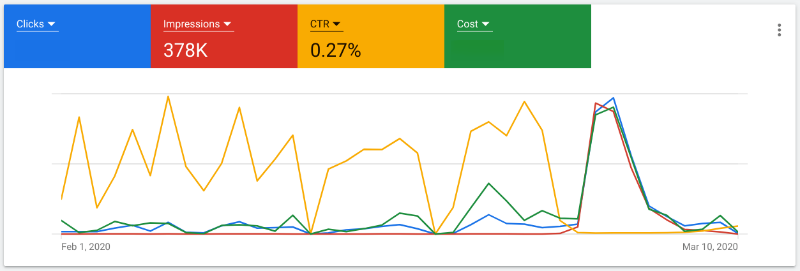
Significant performance changes with Display enabled
This Display Network analysis has:
- The branded search campaigns for a UK-based financial services agency
- These campaigns have an existing, stable history with predictable performance
- The brand name does not include any common terms (like “financial”, “services” or “consulting”), and is highly specific
- Prior to the test, these campaigns were search only, but no other targeting/audience/location changes were made
- The test window is March 1st to March 9th (we use a window to March 5th, as trends quickly trended back down, which we will discuss)
Immediately we can see that enabling the display network resulted in a massive increase in spend and huge drop in click-through rate. Clicks and impressions surged, however. What the hell happened? Let’s take a look at our user location reports first, comparing the test window to the same range the week before:
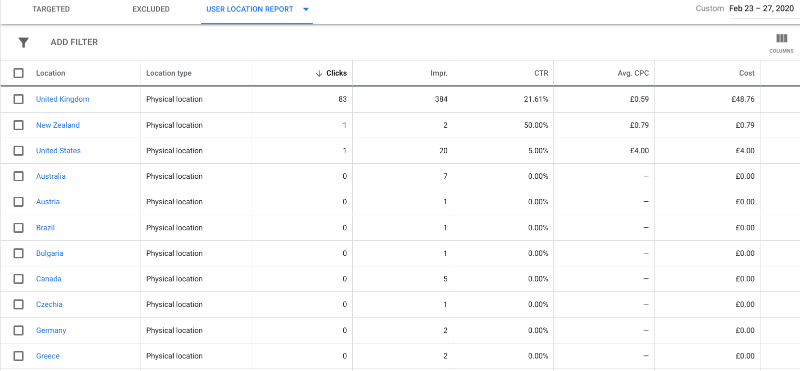
Results before enabling the Google Display network
With search only, we see branded terms mostly focused on the United Kingdom, which is to be expected, as the brand name is regionally limited and specific, not using any broad terms like “financial”, “services”, or “consulting” etc. We see impressions and clicks trickle in, as we have global targeting. It’s the brand name after all! What happened when we enabled the display network?
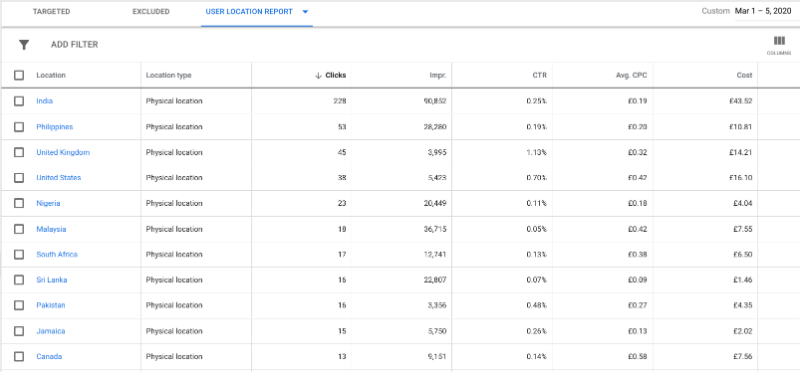
Massive spike in obviously fraudulent results from the Display Network
We see an immediate, massive spike in impressions and clicks. This is across all locations, but we see the United Kingdom, the only location which should have any significant results, fall to third place! India, out of nowhere, has become our biggest source of “branded” visits, and far and away our biggest cost.
Did we run any types of marketing campaigns in India (or the Philippines, Nigeria, Malaysia, etc.)? No, of course not. Are these clicks that are coming through worth anything? Absolutely not. We are only tracking form submissions as goals in Google Ads, which have high quality and intent. We saw zero conversions from these “new” locations.
Where is this Fraud Coming From?
Everywhere, as you can see. But India stands out in particular, which to us is no surprise. In previous tests of the search partners we saw similar results, with Pakistan and Bangladesh filling out the top-three sources of fraudulent/irrelevant clicks then. Here, we see a fairly even distribution of countries with “suddenly increased interest” in our brand. It’s all fake, and it’s having detrimental effects not just on our budget, but on our metrics as well.
Why Does This Fraud Exist?
Google pays website owners through AdSense when someone clicks an ad, charging the advertiser and taking their own cut. Both the content creator and Google have a financial incentive to encourage clicks, and many go further and engage in outright fraud to steal from unsuspecting and unprepared advertisers. Determining whether a website signing up for the service meets the requirements is something that isn’t being particularly well enforced.
Display Network/AdSense Fraud in Practice
There is a strong financial incentive to boost clicks on a site running Google AdSense, and no shortage of places to find spammers looking to game the system. You need look no further than Facebook, where tons of topic groups exist. Just search “AdSense” and you’ll see groups with tens or even hundreds of thousands of members. Hiding in plain sight? Or just being ignored by Facebook? You decide, but here’s some examples from a recent window of time:
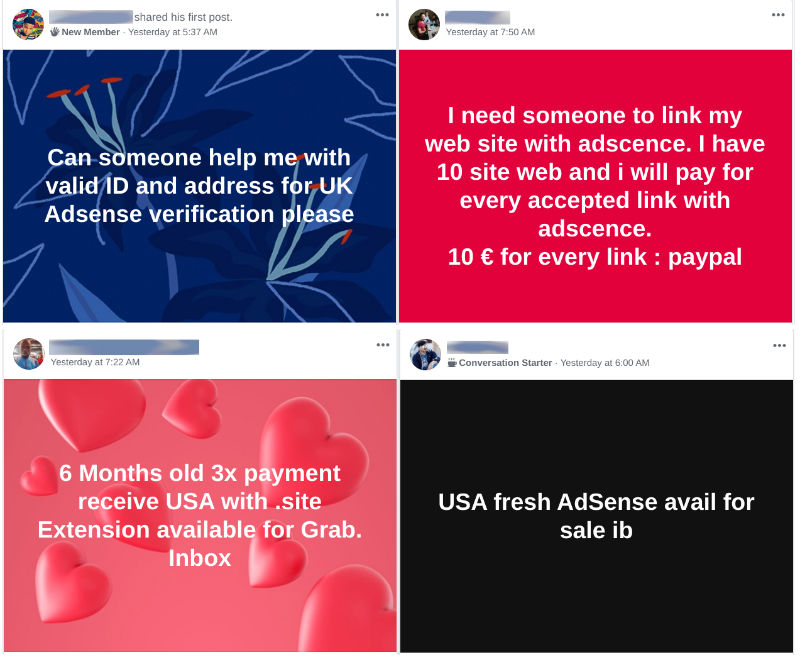
Fraudulent AdSense posts on Facebook
These kinds of posts are incessant, and available in any language of your choosing. The websites that scammers use are typically quickly-created, template websites using re-hashed or otherwise useless content. Google provides their requirements for your website to be accepted:
- Do you have your own unique and interesting content?
- Does your content comply with the AdSense Program policies?
- Are you at least 18 years old?
That’s it. Pretty simple, right? There are additional guides about how your website is set-up, and general policies that cover fraud. The first step for these scammers is to get their template scam page approved, which seems easier than you would expect. You’ll even regularly see people offering to approve websites for a price, which suggest this type of fraud runs deep.
The next step is to get clicks. Seen those “make money from home” spam messages? Many are related to this, as the scammers pay you a cut to dupe Google. They’re even open about how their fraud works:

Fraudulent AdSense CPC Offer
Fraud also exists between AdSense “advertisers”, where they trade clicks with one another. If you think using phone calls as conversions would help, you’d be mistaken. In fact, these in particular show a tendency towards fraudulent conversions. Scammers will set minimum times to stay on the phone to make sure conversions fire, further muddying your results, and suggesting to you that these websites are worth continued investment. Unless you’re being vigilant, you won’t be able to separate individual conversions to determine which are good and which are not.
Are you interested in paying for this kind of traffic from your paid search campaigns? I didn’t think so.
Google uses algorithms to determine whether the clicks and traffic coming in are legitimate. In practice, their algorithms are getting beaten by dedicated fraudsters, and since they make money on each click, there is a definite conflict of interest. Think about a financial adviser selling you his own bank’s products, but much worse and with nearly zero oversight.
Protecting Yourself And Your Budget
So what can you do to protect yourself? Google is actively working to fight against click fraud/invalid clicks, and in most cases you won’t need to do anything if your accounts are properly set up and monitored. After all, they need to protect their business, and are quite obviously more interested in delivering long-term value to their clients, instead of making quick wins that turn off advertisers from continuing. That’s not the case with scammers, as they simply create new fake accounts and template websites.
Google’s Fraud Protection in Practice
As we can see in the initial overview graph, despite running display campaigns from March 1st to March 9th, the spike quickly subsided. It appears that Google’s mechanisms came in, and cut out a great deal of the fraudulent clicks. But this was after the fact. Being reactive like this had negative consequences to our campaigns overall, consequences that continue to reverberate through the campaign.
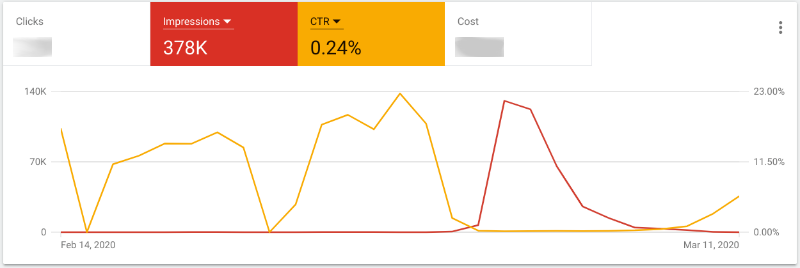
Click through rate (CTR) slowly rebounding
Those consequences, like a depressed click-through rate (CTR) that fell by an order of magnitude, will also have effects on things like Quality Score. Our performance should be returning to normal, but it is by no means immediate as you can see. This means that this click fraud will continue to be felt long after it has been removed.
Unfortunately, Google has a history of legal issues surrounding its handling fraudulent and invalid clicks that is both ongoing, and one that goes back nearly two decades. That being said, there are a few avenues for you to pursue. If you have seen unexpected or fraudulent activity in your accounts, you can reach out to Google directly via their click quality form. You can also see Google’s fraud protection in action through your billings & payments screen:
Refund of invalid activity in Google Ads
As you can see, Google is not only responding to the fraudulent traffic by eliminating it, refunds are also being issued. Unfortunately, this refund is only a fraction of the fraudulent spend. In general, both the process of filing refund requests and the actual refunds themselves, if they come, leave much to be desired.
How Should I Run My Display Campaigns?
Terrible, right? Should you just avoid display campaigns altogether? You don’t have to go to that extreme, but especially with limited budgets, that’s often going to be the decision. If you do want to run display campaigns, there are steps you can take!

Placements of Ads on the Display Network
You can take a look at the websites where your ads have shown through the console, and as we can see just looking at this top-10, the results are not inspiring. You can of course add exclusions, going through and individually adding websites. But remember, the scammers are building template websites with ease. It’s a game of whack-a-mole, on a scale that you simply can’t compete with.
So what can you do?
- Set up location targeting: target specific locations, or exclude those that have no business seeing your ads. We could for example exclude India. This does not stop fraud from the countries you target, however
- Target specific websites: instead of broadly showing ads on the entire display network, then manually excluding fraudulent ones, you can simply choose those websites you want to show your ads on
- Focus on remarketing: display advertising can have fantastic results when used for remarketing. This means you’re not showing ads to every visitor, but just those who already belong to an audience you’ve built (e.g. site visitors that didn’t convert).
How Can You Protect Yourself Against Click Fraud?
We cannot fully rely on Google to both sell us traffic as well as protect us from fraud. After all, the better they get at stopping fraudulent traffic, the lower their revenues. Too much and advertisers may get turned off, but that leads to plenty of leeway.
There are third-party click fraud tools, but real-life reports from industry professionals suggest that they do little if anything on top of Google’s own efforts.
Nobody, whether Google or a dedicated third-party fraud service, will understand the client and industry as well as a sufficiently invested PPC manager. A professionally run search engine marketing campaign will also be aware of the risks and nuances of different channels, and how best to approach them. Nobody will care about your campaigns as much as you will. Protect yourself not just against click fraud, but complacency, by choosing a search engine marketing agency that offers expertise and transparency.



